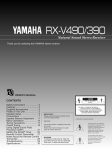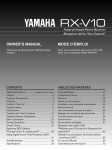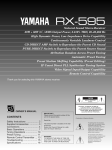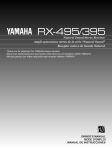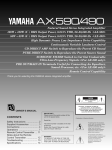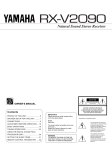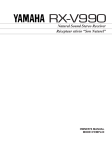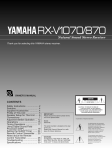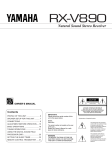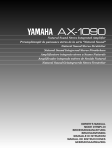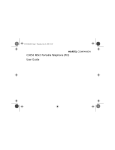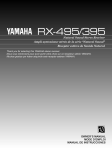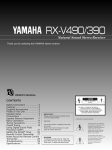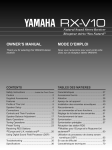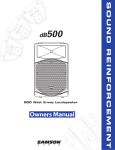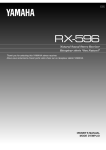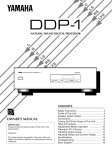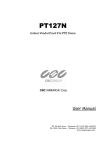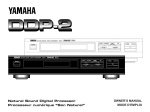Download Yamaha RX-V2090 Receiver
Transcript
RX-V2090 Natural Sound Stereo Receiver CAUTION RISK OF ELECTRIC SHOCK DO NOT OPEN OWNER’S MANUAL CAUTION: TO REDUCE THE RISK OF ELECTRIC SHOCK, DO NOT REMOVE COVER (OR BACK). NO USER-SERVICEABLE PARTS INSIDE. REFER SERVICING TO QUALIFIED SERVICE PERSONNEL. Contents PROFILE OF THIS UNIT ............................ 6 SPEAKER SETUP FOR THIS UNIT ........... 7 CONNECTIONS ......................................... 9 ADJUSTMENT BEFORE OPERATION .... 16 BASIC OPERATIONS .............................. 19 TUNING OPERATIONS ........................... 22 IMPORTANT! Please record the serial number of this unit in the space below. Model: Serial No.: The serial number is located on the rear of the unit. Retain this Owner’s Manual in a safe place for future reference. USING THE DIGITAL SOUND FIELD PROCESSOR (DSP) ................................ 26 SETTING THE SLEEP TIMER ................. 31 REMOTE CONTROL TRANSMITTER ..... 32 WARNING TO REDUCE THE RISK OF FIRE OR ELECTRIC SHOCK, DO NOT EXPOSE THIS UNIT TO RAIN OR MOISTURE. • Explanation of Graphical Symbols The lightning flash with arrowhead symbol, within an equilateral triangle, is intended to alert you to the presence of uninsulated “dangerous voltage” within the product’s enclosure that may be of sufficient magnitude to constitute a risk of electric shock to persons. The exclamation point within an equilateral triangle is intended to alert you to the presence of important operating and maintenance (servicing) instructions in the literature accompanying the appliance. SAFETY INSTRUCTIONS 1 Read Instructions — All the safety and operating A. The power-supply cord or the plug has been damaged; or instructions should be read before the unit is operated. B. Objects have fallen, or liquid has been spilled into the 2 Retain Instructions — The safety and operating unit; or instructions should be retained for future reference. C. The unit has been exposed to rain; or 3 Heed Warnings — All warnings on the unit and in the operating instructions should be adhered to. D. The unit does not appear to operate normally or exhibits a marked change in performance; or 4 Follow Instructions — All operating and other instructions should be followed. E. The unit has been dropped, or the enclosure damaged. 5 Water and Moisture — The unit should not be used near 16 Servicing — The user should not attempt service the water – for example, near a bathtub, washbowl, kitchen sink, laundry tub, in a wet basement, or near a swimming pool, etc. unit beyond those means described in the operating instructions. All other servicing should be referred to qualified service personnel. 6 Carts and Stands — The unit should be used only with a cart or stand that is recommended by the manufacturer. 6A An unit and cart combination should be moved with care. Quick stops, excessive force, and uneven surfaces may cause the unit and cart combination to overturn. 7 Wall or Ceiling Mounting — The unit should be mounted to a wall or ceiling only as recommended by the manufacturer. 8 Ventilation — The unit should be situated so that its location or position does not interfere with its proper ventilation. For example, the unit should not be situated on a bed, sofa, rug, or similar surface, that may block the ventilation openings; or placed in a built-in installation, such as a bookcase or cabinet that may impede the flow of air through the ventilation openings. 17 Power Lines — An outdoor antenna should be located away from power lines. 18 Grounding or Polarization — Precautions should be taken so that the grounding or polarization is not defeated. 19 Outdoor Antenna Grounding — If an outside antenna is connected to this unit, be sure the antenna system is grounded so as to provide some protection against voltage surges and built-up static charges. Article 810 of the National Electrical Code, ANSI/NFPA 70, provides information with regard to proper grounding of the mast and supporting structure, grounding of the lead-in wire to an antenna discharge unit, size of grounding conductors, location of antenna discharge unit, connection to grounding electrodes, and requirements for the grounding electrode. EXAMPLE OF ANTENNA GROUNDING 9 Heat — The unit should be situated away from heat sources such as radiators, stoves, or other appliances that produce heat. MAST GROUND CLAMP 10 Power Sources — The unit should be connected to a power supply only of the type described in the operating instructions or as marked on the unit. 11 Power-Cord Protection — Power-supply cords should be routed so that they are not likely to be walked on or pinched by items placed upon or against them, paying particular attention to cords at plugs, convenience receptacles, and the point where they exit from the unit. 12 Cleaning — The unit should be cleaned only as ANTENNA LEAD IN WIRE ANTENNA DISCHARGE UNIT (NEC SECTION 810-20) ELECTRIC SERVICE EQUIPMENT GROUNDING CONDUCTORS (NEC SECTION 810-21) GROUND CLAMPS POWER SERIVCE GROUNDING ELECTRODE SYSTEM (NEC ART 250, PART H) NEC – NATIONAL ELECTRICAL CODE recommended by the manufacturer. 13 Nonuse Periods — The power cord of the unit should be unplugged from the outlet when left unused for a long period of time. 14 Object and Liquid Entry — Care should be taken so that objects do not fall into and liquids are not spilled into the inside of unit. 15 Damage Requiring Service — The unit should be serviced by qualified service personnel when: Note to CATV system installer: This reminder is provided to call the CATV system installer’s attention to Article 820-40 of the NEC that provides guidelines for proper grounding and, in particular, specifies that the cable ground shall be connected to the grounding system of the building, as close to the point of cable entry as practical. CAUTION: READ THIS BEFORE OPERATING YOUR UNIT 1 To ensure the finest performance, please read this 2 3 4 5 manual carefully. Keep it in a safe place for future reference. Install your unit in a cool, dry, clean place – away from windows, heat sources, and too much vibration, dust, moisture or cold. Avoid sources of hum (transformers, motors). To prevent fire or electrical shock, do not expose to rain and water. Do not operate the unit upside-down. It may overheat, possibly causing damage. Never open the cabinet. If a foreign object drops into the set, contact your dealer. Do not use force on switches, knobs or cords. When moving the set, first turn the unit off. Then gently disconnect the power plug and the cords connecting to other equipment. Never pull the cord itself. 6 Do not attempt to clean the unit with chemical solvents; this might damage the finish. Use a clean, dry cloth. 7 Always set the volume control to “– ∞” before starting 8 9 10 11 the audio source play: increase the volume gradually to an appropriate level after the play is started. To prevent lightning damage, pull out the power cord and remove the antenna cable during an electrical storm. Be sure to read the “Troubleshooting” section on common operating errors before concluding that your unit is faulty. Do not connect audio equipment to the AC outlets on the rear panel if that equipment requires more power than the outlets are rated to provide. When not planning to use this unit for long periods of time (ie., vacation, etc.), disconnect the AC power plug from the wall outlet. The apparatus is not disconnected from the AC power source as long as it is connected to the wall outlet, even if the apparatus itself is turned off. FCC INFORMATION 1. IMPORTANT NOTICE: DO NOT MODIFY THIS UNIT! This product, when installed as indicated in the instructions contained in this manual, meets FCC requirements. Modifications not expressly approved by Yamaha may void your authority, granted by the FCC, to use the product. Compliance with FCC regulations does not guarantee that interference will not occur in all installations. If this product is found to be the source of interference, which can be determined by turning the unit “OFF” and “ON”, please try to eliminate the problem by using one of the following measures: 2. IMPORTANT: When connecting this product to accessories and/or another product use only high quality shielded cables. Cable/s supplied with this product MUST be used. Follow all installation instructions. Failure to follow instructions could void your FCC authorization to use this product in the USA. Relocate either this product or the device that is being affected by the interference. 3. NOTE: This product has been tested and found to comply with the requirements listed in FCC Regulations, Part 15 for Class “B” digital devices. Compliance with these requirements provides a reasonable level of assurance that your use of this product in a residential environment will not result in harmful interference with other electronic devices. This equipment generates/uses radio frequencies and, if not installed and used according to the instructions found in the users manual, may cause interference harmful to the operation of other electronic devices. Utilize power outlets that are on different branch (circuit breaker of fuse) circuits or install AC line filter/s. In the case of radio or TV interference, relocate/ reorient the antenna. If the antenna lead-in is 300 ohm ribbon lead, change the lead-in to coaxial type cable. If these corrective measures do not produce satisfactory results, please contact the local retailer authorized to distribute this type of product. If you can not locate the appropriate retailer, please contact Yamaha Electronics Corp., U.S.A. 6600 Orangethorpe Ave, Buena Park, CA 90620 The above statement apply ONLY to those products distributed by Yamaha Corporation of America or its subsidiaries. We Want You Listening For A Lifetime YAMAHA and the Electronic Industries Association’s Consumer Electronics Group want you to get the most out of your equipment by playing it at a safe level. One that lets the sound come through loud and clear without annoying blaring or distortion – and, most importantly, without affecting your sensitive hearing. Since hearing damage from loud sounds is often undetectable until it is too late, YAMAHA and the Electronic Industries Association’s Consumer Electronics Group recommend you to avoid prolonged exposure from excessive volume levels. SUPPLIED ACCESSORIES After unpacking, check that the following parts are contained. • Remote Control Transmitter Main Remote • Indoor FM Antenna Room 2 Remote SKIP PHONO TRANSMIT USER LEARN /LEARN YPC DISC SKIP POWER SLEEP TV VCR PAUSE/STOP PLAY — PRESET SKIP + A/B/C/D/E TUNER PLAY TAPE 1 STOP TAPE 2 PLAY LD/TV STOP VCR 1 PHONO DISC SKIP SEARCH PAUSE/STOP DECK A/B PRESET DIR A PLAY CD A/B/C/D/E TUNER — + STOP PLAY TAPE 1 REC/PAUSE DIR A DIR B TAPE 2 MON SEARCH PAUSE/STOP PLAY LD/TV CHAPTER/CH DISPLAY STOP VCR 1 VCR 2 SEARCH REC MUTE CD AUX DECK A/B DIR B PAUSE/STOP — CHAPTER + VCR 2 — + PRO LOGIC ENHANCED 70mm MOVIE THEATER TV THEATER 2 3 4 JAZZ CLUB 1 REMOTE BOURCE CONTROLLER V–AUX • AM Loop Antenna SURROUND STADIUM ROCK 5 6 7 CHURCH HALL 9 10 SPORTS V–AUX 8 EFFECT DSP ON/OFF MASTER VOLUME FRONT LEVEL — + + + DELAY TIME REAR LEVEL — + RESET CLEAR + TEST CENTER LEVEL — MUTING — — • Batteries (size AA, LR6, UM-3) 4 • User Program Sheets Features • Seven Speaker Configuration Main: 100 W + 100 W (8Ω) RMS Output Power, 0.015% THD, 20-20,000 Hz 120 W + 120 W (6Ω) RMS Output Power, 0.04% THD, 20-20,000 Hz (USA Model Only) Center: 100 W (8Ω) RMS Output Power, 0.015% THD, 1 kHz Front: 35 W + 35 W (8Ω) RMS Output Power, 0.08% THD, 1 kHz Rear: 35 W + 35 W (8Ω) RMS Output Power, 0.08% THD, 1 kHz • Multi-Room Capability Multi-Room and Multi-Source with two Remote Control Units • Digital Sound Field Processor 10 Programs including “Cinema DSP” 70mm Movie Theater • 5 Channel Discrete Input for Dolby Surround Digital AC-3 • Automatic Input Balance Control for Dolby Surround • Test Tone Generator for Easier Speaker Output Balance Adjustment • 3 Center Channel Modes (NORMAL/WIDE/PHANTOM) • 40-Station Random Access Preset Tuning • Automatic Preset Tuning (FM only) • Preset Station Shifting Capability (Preset Editing) • IF Count Direct PLL Synthesizer Tuning System • Video Signal Input/Output Capability • SLEEP Timer • Remote Control Capability • Program and status messages superimposed on connected video monitor OPEN/CLOSE THE CONTROL DOOR To open the door To close the door When it is not necessary to operate controls inside the control door, close the door. 5 PROFILE OF THIS UNIT You are the proud owner of a Yamaha stereo receiver –an extremely sophisticated audio component. The Digital Sound Field Processor (DSP) built into this unit takes full advantage of Yamaha’s undisputed leadership in the field of digital audio processing to bring you a whole new world of listening experiences. Follow the instructions in this manual carefully when setting up your system, and this unit will sonically transform your room into a totally new listening environment –movie theater, concert hall, and so on. In addition, you get incredible realism from Dolby-encoded video sources using the built-in Dolby Pro Logic Surround Decoder. Please read this owner’s manual carefully and store it in a safe place for later reference. Digital Sound Field Processing What is it that makes live music so good? Today’s advanced sound reproduction technology lets you get extremely close to the sound of a live performance, but chances are you’ll still notice something missing: the acoustic environment of the live concert hall. Extensive research into the exact nature of the sonic reflections that create the ambience of a large hall has made it possible for Yamaha engineers to bring you this same sound in your own listening room, so you’ll feel all the sound of a live concert. Furthermore, our technicians, armed with sophisticated measuring equipment, have even made it possible to capture the acoustics of a variety of venues such as an actual concert hall, theater, etc. to allow you to accurately recreate one of several actual live performance environments, all in your own home. Dolby Pro Logic Surround The Dolby Pro Logic Surround Decoder program lets you experience the dramatic realism and impact of Dolby Surround movie theater sound in your own home. Dolby Pro Logic gets its name from its professional-grade steering logic circuitry, which provides greater effective front and rear channel separation for a much higher degree of realism than the “passive” Dolby Surround circuits found in less sophisticated home audio/video equipment. Dolby Pro Logic Surround provides a true center channel, so that there are four independent channels, unlike passive Dolby Surround which has in effect only three channels: left, right, and rear. This center channel allows listeners seated in even less-than-ideal positions to hear the dialog originating from action on the screen while getting a stereo effect as well. This Dolby Pro Logic Surround Decoder employs a digital signal processing system. This system increases sound stability at each channel and minimizes crosstalk between channels compared to conventional analog Dolby signal processing. In addition, this unit features a built-in automatic input balance control. This circuit always presents you the best surround conditions without performing manual adjustments. Dolby Pro Logic Surround + DSP You can also enjoy Dolby Pro Logic with two modes of Digital Sound field processing. These combinations expand the surround effect. One is the “ENHANCED” Dolby Pro Logic Surround which recreates the surround effect of the 35 mm film movie theater. The other is the sound field program ”70 mm MOVIE THEATER”. Which recreates the listening experience of a 70 mm film theater. Directional Enhancement Circuit + DSP The newly featured directional enhancement circuit expands and focuses the digital sound field by emphasizing position of sound. This effect puts you in the midst of the action, while centering and focusing your attention to the screen. This circuit is available on the sound field program “TV THEATER” and “SPORTS”. 6 CINEMA DSP The YAMAHA “CINEMA DSP” logo indicates these programs are created by the combination of Dolby Pro Logic and YAMAHA DSP technology. SPEAKER SETUP FOR THIS UNIT SPEAKERS TO BE USED This unit is designed to provide the best sound-field quality with a seven speaker configuration. The speakers to be used with this unit will be main speakers, front speakers, rear speakers, and a center speaker. The main speakers are used for the main source sound. These are usually a much larger, high-quality loudspeaker than you will use for the surround sound effects. The center speaker is used for the center sound (dialog, etc.) encoded with the Dolby Surround. And the front and rear speakers are used for special effects that enhance the surround sound. The front, rear, and center speakers do not need to be equal to the main speakers. However, all the speakers should have high enough power handling to accept the maximum output of this unit. SPEAKER CONFIGURATION Seven-Speaker Configuration This configuration is the most effective and recommended one. In this configuration, the front speakers and the center speaker are necessary along with the rear speakers. If the digital sound field program DOLBY PRO LOGIC, DOLBY PRO LOGIC ENHANCED, 70 mm MOVIE THEATER, TV THEATER, or SPORTS is selected, conversations will be output from the center speaker and the ambience will be excellent. • The FRONT MIX switch on the rear panel should be set to the “7 ch” setting. (For details, refer to page 17.) • Set the center channel mode to the “NORMAL” or “WIDE” position. (For details, refer to page 17.) Five-Speaker Configuration When you only have five speakers, this configuration can be very effective. In this configuration, the center speaker is used for dialog when you select the digital sound field program DOLBY PRO LOGIC, DOLBY PRO LOGIC ENHANCED, 70 mm MOVIE THEATER, TV THEATER, or SPORTS. The front speakers are not used. The main speakers handle the front channel effects. • The FRONT MIX switch should be set to the “5 ch” setting. (For details, refer to page 17.) • Set the center channel mode to the “NORMAL” or “WIDE” position. (For details, refer to page 17.) Main L Center Main R Front L Front R Dialogue Surround sound Rear R Rear L Main L Center Main R Dialogue Surround sound Rear L Rear R Main L Main R Four-Speaker Configuration The center speaker is not used in this configuration. If the digital sound field program DOLBY PRO LOGIC or DOLBY PRO LOGIC ENHANCED is selected, the center sound along with the front effects are output from the left and the right main speakers. However, the sound effect of other programs can be the same as that of the other configurations. • Be sure to set the center channel mode to the “PHANTOM” position. (For details, refer to page 17.) Dialogue Surround sound Rear L Rear R 7 SPEAKER PLACEMENT The recommended speaker configuration, the seven-speaker configuration, will require three speaker pairs: main speakers, front speakers, and rear speakers, plus a center speaker. When you place these speakers, refer to the following: Front L Main L Main R Center Rear R Rear L 8 In normal position. (The position of a standard stereo speaker setup) Front: Placed much further apart than the Main speakers, facing slightly inwards. Nearly six feet (approx. 1.8 m) up from the floor. Center: Precisely between the main speakers. (To avoid interference with TV sets, use a magnetically shielded speaker.) When two center speakers are used, place these to the right and left of your TV set or video monitor. Rear: Behind your listening position, facing slightly inward. Nearly six feet (approx. 1.8 m) up from the floor. Main: Front R CONNECTIONS CAUTION Before attempting to make any connections to or from this unit, be sure to first switch OFF the power to this unit and to any other components to which connections are being made. CONNECTIONS WITH OTHER COMPONENTS When making connections between this unit and other components, be sure all connections are made correctly, that is to say L (left) to L, R (right) to R, “+” to “+” and “–” to “–”. Also, refer to the owner’s manual for each component to be connected to this unit. Turntable Video cassette recorder 1 GND AUDIO OUT AUDIO IN VIDEO OUT VIDEO IN OUTPUT Compact disc player Video cassette recorder 2 AUDIO SIGNAL VIDEO SIGNAL AUDIO SIGNAL S VIDEO VIDEO Tape deck 1 PHONO LINE OUT GND LINE OUT FM ANT 75Ω UNBAL. Tape deck 2 VCR 1 VCR 1 OUT OUT TAPE PB IN IN TAPE 1 VCR 2 VCR 2 REC OUT OUT OUT TAPE PB LD/TV LD/TV LD/TV MAIN MONITOR OUT LD/TV CENTER FRONT MIX AUDIO OUT VIDEO OUT VIDEO IN AUDIO IN TAPE 2 REC OUT GND 5CH DISCRT INPUT MAIN IN ON 5ch OFF 7ch MAIN CH PRE OUT MAIN LEVEL VIDEO IN LD/TV SURROUND 0dB AUDIO PRE OUT -10dB VIDEO OUT ROOM 2 OUT IN OUT Monitor TV REMOTE CONTROL VIDEO OUT LINE IN IN CD AUDIO OUT LINE IN AM ANT IN LaserDisc-Spieler 9 CONNECTING SPEAKERS Connect the respective speakers to this unit as shown below: Front speakers Main speakers A Right Right Left Rear speakers Left Right Left SPEAKERS FRONT REAR OUTPUT FRONT OUT LOW PASS CENTER OUT REAR OUT fo:200Hz 8ΩMIN. /SPEAKER 8ΩMIN. /SPEAKER CENTER A B C D D C C+D A OR B: 5ΩMIN. /SPEAKER A + B:l2ΩMIN. /SPEAKER Right C C: 8ΩMIN. /SPEAKER C+ D: 4ΩMIN. /SPEAKER Left Center speaker(s) Main speakers B Note on main speaker connection: One or two speaker systems can be connected to this unit. If you connect only one speaker system, connect it to either the SPEAKERS A or B terminals. Note: Use speakers with the specified impedance shown on the rear of this unit. For connecting to the SPEAKER terminals Note on center speaker connection: One or two center speakers can be connected to this unit. If you cannot place the center speaker on or under the TV, it is recommended to use two center speakers and place them on both sides of the TV to orient the center sound at the center position. When connecting two center speakers, be sure to press the CENTER speaker switch into the “C+D” position ( ) . When you use a single center speaker, set the switch to the “C” position( ) . Red: positive (+) Black: negative (–) How to Connect: Connect the SPEAKERS terminals to your speakers with wire of the proper gauge, cut as short as possible. If the connections are faulty, no sound will be heard from the speakers. Make sure that the polarity of the speaker wires is correct, that is, + and – markings are observed. If these wires are reversed, the sound will be unnatural and will lack bass. Banana Plug connections are also possible. Simply insert the Banana Plug connector into the corresponding terminal. (Not available on Singapore model.) CAUTION Do not let the bare speaker wires touch each other and do not let them touch the metal parts of this unit. This could damage this unit and/or the speakers. 10 2 1 3 1 Unscrew the knob. 2 Insert the bare wire. [Remove approx. 5mm (1/4") insulation from the speaker wires.] 3 Tighten the knob and secure the wire. Note: Use only single type banana plug cable. ABOUT THE ACCESSORY TERMINALS OUTPUT FRONT OUT LOW PASS 3 CENTER OUT 4 1 REAR OUT fo:200Hz 2 1 LOW PASS terminal This terminal is for output to a monaural amplifier driving a subwoofer. Frequencies above 200␣ Hz are filtered out so that only the bass range remains. The output signal is from the main and center channels. You may wish to add a subwoofer to reinforce the bass frequencies. Connect the LOW PASS terminal to the INPUT terminal of the subwoofer amplifier, and connect the speaker terminals of the subwoofer amplifier to the subwoofer. With some subwoofers, including the Yamaha Active Servo Processing Subwoofer System, the amplifier and subwoofer are in the same unit. 2 CENTER OUTPUT terminal This terminal is for center channel line output. There is no connection to this terminal when you use the built-in amplifier. However, if you drive a center speaker with an external power amplifier, connect the input terminal of the external amplifier to this terminal. 3 FRONT OUTPUT terminals These terminals are for front channel line output. There is no connection to these terminals when you use the built-in amplifier. However, if you drive front speakers with an external stereo power amplifier, connect the input terminals of the external amplifier (MAIN IN or AUX terminals of a power amplifier or an integrated amplifier) to these terminals. 4 REAR OUTPUT terminals These terminals are for rear channel line output. There is no connection to these terminals when you use the built-in amplifier. However, if you drive rear speakers with an external stereo power amplifier, connect the input terminals of the external amplifier (MAIN IN or AUX terminals of a power amplifier or an integrated amplifier) to these terminals. GND terminal (For turntable use) Connecting the ground wire of the turntable to this terminal will normally minimize hum. In some cases, better results may be obtained with the ground wire disconnected. GND AC OUTLETS 2 SWITCHED OUTLETS and 1 UNSWITCHED OUTLET (USA, Canada, and General models) 1 SWITCHED OUTLET (Australia model) 2 SWITCHED OUTLETS (Singapore model) SWITCHED UNSWITCHED 120V 60Hz 120W MAX. TOTAL 120V 60Hz 200W MAX. (USA model) Use these to connect the power cords from your components to this unit. The power to the SWITCHED outlets is controlled by this unit’s POWER switch or the provided remote control transmitter’s POWER key. These outlets will supply power to any connected component whenever this unit is turned on. The maximum power (total power consumption of components) that can be connected to the SWITCHED AC OUTLET(S) is 120 watts. The power to the UNSWITCHED outlets cannot be controlled by this unit’s POWER switch or the provided remote control transmitter’s POWER key. (USA, Canada, and General models only). The maximum power (power consumption of component) that can be connected to the UNSWITCHED AC OUTLET is 200 watts (USA model), 180 watts (Canada model) and 200 watts (General model). 11 A TAPE 2 REC OUT 5 5CH DISCRT INPUT MAIN IN LD/TV MAIN MONITOR OUT LD/TV CENTER FRONT MIX ON 5ch OFF 7ch 0 MAIN CH 6 PRE OUT 7 MAIN LEVEL 9 LD/TV SURROUND 0dB AUDIO PRE OUT -10dB VIDEO OUT ROOM 2 OUT IN OUT REMOTE CONTROL 8 5 MAIN␣ CH — MAIN␣ IN terminals These terminals are for line input to the built-in main channel amplifier. Leave the jumper bars connected to the PRE␣ OUT terminals when you use the built-in amplifier. However, if you drive main speakers with an external stereo power amplifier, remove the jumper bars. 6 MAIN␣ CH — PRE␣ OUT terminals These terminals are for main channel line output. Leave the jumper bars connected to the MAIN␣ IN terminals when you use the built-in amplifier. However, if you drive main speakers with an external stereo power amplifier, remove the jumper bars and connect the input terminals of the external amplifier (MAIN IN or AUX terminals of a power amplifier or an integrated amplifier) to these terminals. 7 MAIN LEVEL switch Normally set to “0␣ dB”. If desired, you can decrease the output level at the MAIN SPEAKERS terminals by 10␣ dB by setting this switch to “–10␣ dB”. 8 ROOM 2 OUT — AUDIO PRE OUT, VIDEO OUT terminals These terminals output audio and video signals to the equipment in the second room. The signal source is selected using the Room 2 Remote transmitter. Refer to “Connecting to Room 2 Equipment” on page 14. 12 9REMOTE CONTROL — IN, OUT terminals IN This terminal receives the commands from the Room 2 Remote transmitter. OUT This terminal outputs the commands at the IN terminal from Room 2 Remote transmitter. Refer to “Connecting to Room 2 Equipment” on page 14. 0 FRONT MIX switch This switch should be set to match the number of speakers in your system. For seven speaker configurations, set it to “7 ch”. For five speaker configurations, set it to “5 ch”. A 5CH DISCRT INPUT terminals These terminals are used with a Dolby Surround AC-3 decoder. Connect the main audio output of the decoder to the LD/TV MAIN input terminals, the center channel audio output to the LD/TV CENTER input terminal, and the surround audio output to the LD/TV SURROUND input terminals. Note: 5CH DISCRT INPUT terminals can only be used with an AC-3 decoder. When you use a Dolby Surround AC-3 decoder, the LFE (Low Frequency Effect channel) signal coming from the AC-3 decoder to this unit must be mixed with the main output signal. Refer to your AC-3 decoder’s operating manual for information about mixing these signals mode. CONNECTING S␣ VIDEO TERMINALS If your video cassette recorder, video disc player, monitor, etc., is equipped with “S” (high-resolution) video terminals, connect them to this unit’s S␣ VIDEO terminals. Otherwise, use the composite video terminals of the unit. Note: • If video signals are sent to both the S␣ VIDEO input and composite input terminals, the input signals will be sent to the respective S␣ VIDEO output and composite output terminals independently. VIDEO SIGNAL VIDEO S VIDEO IN OUT VIDEO OUT VIDEO IN VCR 2 VIDEO IN S VIDEO IN IN S VIDEO IN S VIDEO OUT VIDEO OUT OUT S VIDEO OUT VCR 1 LD/TV Video Cassette recorder 1 MONITOR OUT Video Cassette recorder 2 VIDEO IN S VIDEO IN S VIDEO OUT VIDEO OUT LD player Monitor TV ON SCREEN DISPLAY If you connect a video cassette recorder, video disc player, monitor, etc., to this unit, you can display DSP program names and information about the other settings and adjustments on the video monitor screen which is connected to MONITOR OUT terminal (cannot display on ROOM 2 moinitor). This information is superimposed over the video image. If there is no program material on the monitor, the information will be displayed over a monochromatic background. Notes: • If you use a video monitor that is connected to both the S␣ VIDEO and composite terminals, the screen display information is only output from the S␣ VIDEO terminals. • When no video signal is input to any of the S␣ VIDEO or composite video input terminals, the screen display information is output from the S␣ VIDEO and composite MONITOR OUT terminals with a monochromatic background. CONNECTING TO VIDEO AUX TERMINALS (FRONT PANEL) These terminals are used to connect any video input source such as a camcorder to this unit. VIDEO AUX 8 VIDEO VIDEO L AUDIO R AUDIO OUT AUDIO OUT VIDEO OUT R 8 VIDEO VIDEO S-VIDEO L Camcorder S VIDEO OUT 13 CONNECTING TO ROOM 2 EQUIPMENT With the Room 2 Remote transmitter you can select a different sound and video source for a second room. To use the multi-room functions of this unit you need the following additional,optional products: • An infrared signal receiver for the second room. (WCX-10) • Master Zone Controller (MCX-10) • An infrared emitter in the main room. (IRX-10/20) This emitter transmits the infrared signals from the Room 2 Remote transmitter in the second room to the other components in the main rooms (for example, the remote for your laserdisc player). • An amplifier and speakers for the second room. • A video monitor for the second room. Note Since there are so many ways to connect and use your RX-V2090 in a multi-room installation, we recommend that you consult with a custom installation specialist for the Room 2 connections which will best meet your requirements. Sample Room 2 connections: Main Room Second Room Amplifier Video monitor Cassette deck, etc Room 2 Remote * REMOTE CONTROL IN ROOM 2 VIDEO OUT ROOM2 AUDIO PREOUT RX-V2090 Infrared signal receiver (WCX-10) Infrared emitter (IRX-10/20) Master Zone Controller MCX-10 MCX-10 Yamaha models are able to connect directly to the RX-V2090 via the REMOTE OUT terminals. If you own * Some these products, the use of an infrared emitter may not be necessary. CAUTION In some cases, adjustments made using the Room 2 Remote transmitter may not be evident on this unit. For example, if both the main room and second room are set to the tuner, it is possible for the person in the second room to change the station. This may be a problem, especially when you are taping a source without directly monitoring it. Using the Remote Transmitters If you use the Room 2 Remote transmitter (the transmitter for the second room) in the main room, the input selector keys of this remote affect the settings in the second room, not the main room. The other keys on the transmitter work the same in both the main room and the second room. If you use the Main Remote transmitter (the transmitter for the main room) in the second room, the keys that also appear on the Room 2 Remote transmitter work except the input selector keys. ROOM 2 ROOM 2 CONTROL 14 1 2 The indicator information: 1 Lights up momentarily when the Room 2 Remote transmitter is used in the main room. 2 Lights up momentarily when the Room 2 Remote transmitter is used in the second room. ANTENNA CONNECTIONS • Each antenna should be connected to the designated terminals correctly, referring to the following diagram. • Both AM and FM indoor antennas are included with this unit. In general, these antennas will probably provide sufficient signal strength. Nevertheless, a properly installed outdoor antenna will give clearer reception than an indoor one. If you experience poor reception quality, an outdoor antenna may result in improvement. Outdoor AM antenna Outdoor FM antenna AUDIO SIGNAL AM loop antenna (included) AUDIO PHONO CD TAPE PB AM ANT TAPE 1 300-ohm feeder GND REC OUT FM ANT TAPE PB 75Ω UNBAL. TAPE 2 REC OUT GND 5CH DISCRT INPUT MAIN IN MAIN CH PRE OUT 75-ohm coaxial cable 75-ohm/300-ohm antenna adapter MAIN LEVEL 0dB -10dB Indoor FM antenna (included) Ground Connecting the AM loop antenna 1 2 ➀ ➂ 3 Orient so that the best reception is obtained. ➁ • The AM loop antenna should be placed apart from the main unit. The antenna may be hung on a wall. • The AM loop antenna should be kept connected, even if an outdoor AM antenna is connected to this unit. GND terminal For maximum safety and minimum interference, connect the GND terminal to a good earth ground. A good earth ground is a metal stake driven into moist earth. Notes: • When connecting the indoor FM antenna, insert its connector into the FM ANT terminal firmly. • If you need an outdoor FM antenna to improve FM reception quality, either 300-ohm feeder or coaxial cable may be used. In locations troubled by electrical interference, coaxial cable is preferable. 15 ADJUSTMENT BEFORE OPERATION SPEAKER BALANCE ADJUSTMENT This procedure lets you adjust the sound output level balance between the main, front, center, and rear speakers using the built-in test tone generator. With this adjustment, the sound output level heard at the listening position will be the same from each speaker. This is important for the best performance of the digital sound field processor. The adjustment of each speaker output level should be done at your listening position with the remote control transmitter. Otherwise, the result may not be satisfactory. 1 TRANSMIT USER LEARN /LEARN YPC 6 POWER SLEEP TV VCR SKIP AUX 5 PHONO DISC SKIP SEARCH — REC MUTE 3 4 CD TUNER STOP PLAY TAPE 1 DIR A DIR B TAPE 2 MON PRESET SEARCH 2 PLAY A/B/C/D/E PAUSE/STOP DECK A/B REC/PAUSE + * If you have a video monitor connected to this unit, you should use it to display the on screen information. The easy-to-read information will help you to perform this adjustment. Note: Before adjustment, make sure that the mute circuit is not engaged. While mute is engaged, no sound will be heard and an indicator on the master VOLUME control flashes. See page 21 for details. 1 4 Set to the “∞” position. VOLUME l8 l6 l4 20 l2 24 USER YPC LEARN l0 28 8 34 6 4 40 3 50 2 60 For detailed information about the remote control transmitter, refer to “REMOTE CONTROL TRANSMITTER” on page 32. l 70 0 –dB 2 5 Set to the “0” position. BASS l 0 2 2 l 2 3 4 3 4 5 4 5 5 6 Set to the “0” position. BALANCE l 0 Select the main speakers to be used. SPEAKERS A B l 2 2 3 3 4 4 L 5 16 0 2 3 4 3 l POWER Press the POWER switch to turn on the power. TREBLE l 3 5 Set the remote YPC-USER-LEARN switch to the “YPC” position. 5 R • If you use two main speaker systems, press both the A and B switches. 7 CHAPTER/CH DISPLAY STOP VCR 1 — + PRO LOGIC ENHANCED 70mm MOVIE THEATER TV THEATER VCR 2 2 3 4 JAZZ CLUB 1 SURROUND STADIUM ROCK 5 6 7 CHURCH SPORTS HALL 9 10 V–AUX 8 EFFECT DSP ON/OFF MASTER VOLUME FRONT LEVEL — + + + + RESET CLEAR 9 DELAY TIME REAR LEVEL — + TEST CENTER LEVEL — MUTING — — 8 7 Select the center channel output mode according to your speaker configuration. (Refer to “SPEAKER CONFIGURATION” on page 7.) Press the TEST button again to run the DSP test. • DSP test: CENTER MODE NORMAL WIDE PHANTOM 8 9 TEST Press the TEST button to run the Dolby test. Turn up the volume using the remote control transmitter. You will hear a test tone (like pink noise) from the left main speaker, then the center speaker, then the right main speaker, and then the rear speakers, for about two seconds each. The display changes as shown below. There are two types of tests: Dolby test and DSP test. • Dolby test: The test tone from the left main speaker and the right main speaker, the left front and the right front speaker will be heard at the same time. To adjust the FRONT LEVEL, go to step 13. Note: When the FRONT MIX switch is set to “5ch” (5 channel mode) the DSP test mode is not available. • If your video monitor is on, the state of the test tone output is also shown by an image of an audio listening room on the screen. In step 7, when you select the center mode, note the following. Seven and five speaker configuration NORMAL: * * The test tone from the left rear speaker and the right rear speaker will be heard at the same time. To adjust the BALANCE, CENTER LEVEL and the REAR LEVEL, go to steps 10~12. WIDE: Select this mode when you use a center speaker that is smaller than the main speakers. In this mode, the bass tone will be output from the front main speakers. Select this mode when your center speakers are approximately the same size as the main speakers. Note: For seven speaker configurations, the FRONT MIX switch on the rear panel should be set to the “7 ch” setting. For five speaker configurations, the FRONT MIX switch should be set to the “5 ch” setting. Six and Four speaker configuration PHANTOM: Select this mode when you do not have a center speaker. The center channel sound will be output from the left and right main speakers. 17 13 CHAPTER/CH DISPLAY STOP VCR 1 — + PRO LOGIC ENHANCED 70mm MOVIE THEATER TV THEATER VCR 2 2 3 4 JAZZ CLUB 1 SURROUND SPORTS 13 11 11 STADIUM ROCK 5 6 7 CHURCH HALL 9 10 DSP — + + MASTER VOLUME + — + RESET CLEAR + TEST CENTER LEVEL — DELAY TIME MUTING — — 14 10 12 the BALANCE control so that the test tone sound 10 Adjust output level of the left front speaker and the right front ON/OFF FRONT LEVEL REAR LEVEL 12 V–AUX 8 EFFECT the test tone sound output level of the front 13 Adjust speakers to be at the same level as that of the main speakers with the FRONT LEVEL keys. (DSP test) speaker are the same. BALANCE l 0 LEVEL FRONT l 2 2 3 3 4 4 L 5 5 R the test tone sound output level of the center 11 Adjust speaker to be at the same level as that of the main speakers with the CENTER LEVEL keys. (Dolby test) 14 Cancel the test tone. LEVEL CENTER TEST PRO LOGIC The previous mode is selected. the sound output level of the rear speakers to be 12 Adjust at the same level as that of the main speakers with the REAR LEVEL keys. (Dolby test) LEVEL REAR Notes: • If the center channel mode is in the “PHANTOM” position, the sound output level of the center speaker cannot be adjusted. This is because in this mode, the center sound is automatically output from the left and right front speakers. • When the FRONT MIX switch is set to 5ch, front level adjustment cannot be executed from the front panel or from the REMOTE CONTROL TRANSMITTER. • You cannot adjust the front level when the LD/TV switch is set to 5CH DISCRT mode. • If you press the LEVEL +/– switch without previously pressing the FRONT, CENTER, or REAR switch, the last channel selected will be changed. 18 Notes: • Once you have completed these adjustments, you can adjust whole sound level on your audio system by using the VOLUME control (or the MASTER VOLUME keys on the remote control transmitter). • If you use external power amplifiers, their volume controls may also need to be adjusted to achieve the proper balance. If there is insufficient sound output from the center and rear speakers, you may decrease the main speaker output level by setting the MAIN LEVEL switch on the rear panel to “–10 dB”. BASIC OPERATIONS 2 3 1,6 4 To play a source 1 5 Set to the “∞” position. VOLUME l8 l6 Play the source. (For detailed information on the tuning operation, refer to page 22.) l4 20 l2 24 l0 28 6 8 34 6 Adjust to the desired output level. 4 40 VOLUME 3 50 l8 l4 l2 24 l 70 l6 20 2 60 l0 28 0 –dB 8 34 6 4 40 2 3 50 POWER Press the POWER switch to turn on the power. 2 60 l 70 0 –dB 3 If desired, adjust the BASS, TREBLE, BALANCE controls, etc. (refer to page 21) and use the digital sound field processor. (Refer to page 26.) Select the desired input source by using the input selector buttons. (For video sources, turn the video monitor ON.) TAPE 2 MONITOR TAPE 1 VIDEO AUX TUNER VCR 2 CD VCR 1 PHONO LD/TV • The name of the selected input source will appear on the display. 4 Select the main speakers to be used. SPEAKERS A B • If you use two main speaker systems, press both the A and B switches. Notes on using the input selector buttons • Note that pressing on each input selector button selects the source which is connected to the corresponding input terminals on the rear panel. • To select the source connected to the VIDEO AUX terminals on the front panel, press VIDEO AUX. • The selection of TAPE 2 MONITOR cannot be canceled by pressing another input selector button. To cancel it, press TAPE 2 MONITOR again. When you select a button other than TAPE 2 MONITOR, make sure that TAPE 2 MONITOR is not accidently selected as well. • If you select the input selector button for a video source without canceling the selection of TAPE 2 MONITOR, the playback result will be the video image from the video source and the sound from the audio tape. • Once you play a video source, its video image will not be interrupted even if the input selector button for an audio source is selected. • For the LD/TV input selector button, refer to page 28. To turn off the power Press the POWER switch again. 19 2 1 To record a source to tape (or dub from tape to tape) 1 Select the source to be recorded. REC OUT SOURCE LD/TV TAPE 1 VCR 1 TUNER CD VCR 2 PHONO VIDEO AUX 2 Play the source and press the corresponding input selector, then turn the VOLUME control up to confirm the input source. (For detailed information on the tuning operations, refer to page 22.) VOLUME TAPE 2 MONITOR TAPE 1 l8 TUNER CD l6 20 PHONO l4 l2 24 l0 28 8 34 VIDEO AUX VCR 2 VCR 1 6 LD/TV 4 40 3 50 2 60 l 70 0 –dB 3 4 20 Set the tape deck or VCR to the recording mode. To monitor a source selected by the REC OUT selector, press the corresponding input selector button. Notes: • When the REC OUT selector is set to “SOURCE”, the source selected by the input selector buttons is output through the TAPE 1-REC OUT, the TAPE 2-REC OUT , the VCR 1-OUT, and the VCR 2-OUT terminals. • When the REC OUT selector is set to something other than “SOURCE” and you press an input selector button other than the one you pressed in step 2, the recording source will not be changed and you can enjoy another source while recording. • To record from tape deck 2, set the REC OUT selector to SOURCE, and press the TAPE 2/MONITOR input selector. • If the tape deck connected to the TAPE 2 REC OUT terminal has 3-head monitoring capability, you can monitor the signal just recorded on the tape by pressing the TAPE 2/MONITOR switch. • DSP, VOLUME, BASS, TREBLE and BALANCE control settings have no effect on the material being recorded. • Signals connected to the 5CH DISCRT INPUT are not output to the tape decks or video recorders. To record the signals from an LD player, you must connect the player to the LD/TV terminals. • It is possible for someone in the second room to use the Room 2 Remote transmitter to change the source you selected for recording. For example, if you are recording a program from the tuner and the person in the second room changes the station. If you are listening to another source, you may not discover this error until you playback the recording.




















